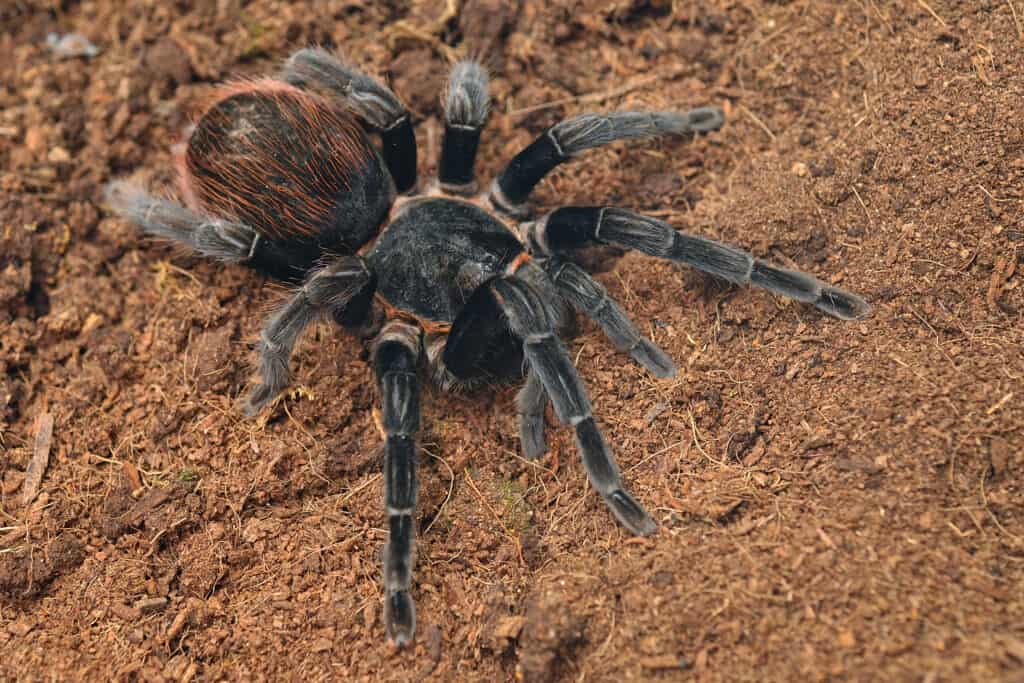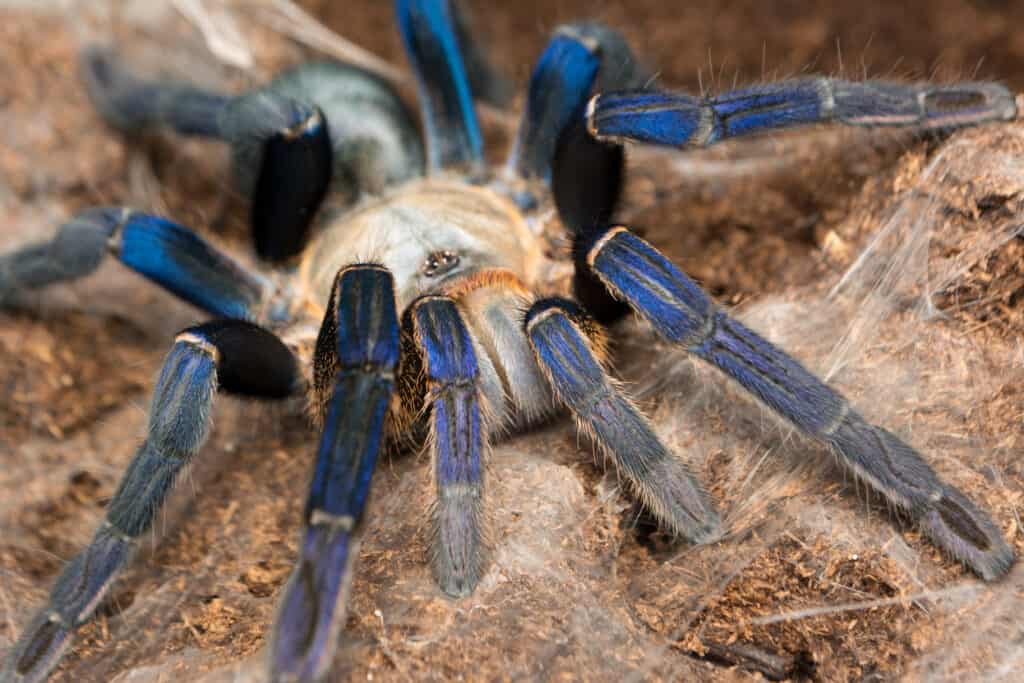The tarantula is one of the biggest spiders in the world. Famous for their menacing appearance, some people find these massive-sized critters scary, but many have come to appreciate the beauty of the four-legged arachnid enough to want to keep them as pets. Of course, the tarantula does have a natural habitat in the wild which varies from one species to the other.
The name “tarantula” was derived from the town of Taranto, Italy. However, they’re widespread and found across various locations around the world. As of August 2022, 1,040 species have been found with 156 genera. A good number of these are found naturally in the southwestern United States, Mexico, and tropical America. Read on to find out more about the tarantula’s habitat and some of their fascinating habits.
Habitats—Where Do Tarantulas Live?

Tarantulas are found in various different habitats – including deserts and forests
©D. Kucharski K. Kucharska/Shutterstock.com
Tarantulas live in terrestrial habitats all over the world. They exist on every continent in the world except Antarctica. There are over a thousand species of tarantulas, and they’re located in a wide range of ecosystems.
They mostly live in warm areas. South America has the largest variety of tarantulas in the world. Hundreds of these spiders are also found in tropical, subtropical, and desert regions on this continent. They vary in color and behavior according to their distinctive environments. 57 tarantula species can be found in the southwestern part of the United States alone.
In places where they’re found, the habitats of these giant spiders tend to vary considerably. Tarantulas are either ground dwellers or arboreal. Most North American varieties live on the ground. However, many also live on trees, cliffs, or caves.
Some tarantulas make burrows beneath the soil. Others live in rocks, barks, logs, and webbed holes within trees. North American tarantulas are mostly found beneath the soil because they’re ground dwellers. Some species, such as the desert tarantulas, often hide in holes.
Tarantula Distribution Based on Geographic Location—Old and New World Tarantulas

Some tarantulas – such as the trapdoor tarantula – live in the Old World, while others live in the New World
©Tobias Hauke/Shutterstock.com
Generally, tarantulas are grouped into Old World and New World tarantulas. This classification is based on the natural geographical location of their native habitats. Old World tarantulas are from the eastern hemisphere. This includes the continents of Asia, Africa, Europe, and Australia. New World tarantulas come from North and South America, including Central America.
In Africa, the Old World tarantulas are abundant in central, eastern, and southern Africa. Due to the different ecosystems of their respective locations, Old and New World spiders have evolved differently to adapt to their environment. The Old World spiders are generally agile and aggressive, while the New World varieties are more docile. The docile nature of the New World spiders and their mild venom make them easier to handle, which is why they’re typically more common as pets. The opposite is true for the Old World spiders. They’re quicker and more defensive than their counterparts.
Common Habits—How Do Tarantulas Live?

Most tarantulas hunt during the night where they prey on a variety of different animals.
©xtotha/Shutterstock.com
Tarantulas are nighttime hunters. You’d barely find them around during the day. But they’re more active at night when the insects they feed on, such as grasshoppers, beetles, centipedes, and spiders, are abundant. They may also eat lizards and small rodents. However, it’s imperative to note that size plays a massive role in their diet. Larger tarantula species have been known to kill and eat small snakes, birds, mice, and bats within their habitat.
All species of this spider are solitary. This means they prefer living independently rather than forming complex social structures or colonies. Male and female tarantulas may be found together during their most active months between September and October.
Mating is an integral part of the tarantula’s life. In fact, it seems the males of most species live for this, typically dying off a few months after mating. Although they prefer to stay hidden, males may venture out of their preferred habitats during mating season.
Female tarantulas provide some level of parental care for their young. Typically, they seal eggs and sperm in a silk cocoon and guard it for six to nine weeks, after which several hatchlings emerge. The female watches the cocoon until the spiderlings come out on their own. After about the first three weeks of life, the young are ready to start living independently in the wild.
Tarantula Habitat for Pets

Tarantulas have fast become a popular pet, but it’s important to make sure that they have a suitable habitat
©iStock.com/waldru
Despite their reputation, owning a tarantula is fast becoming popular. They are noiseless, aesthetically pleasing, and they require very little maintenance. However, if you intend to own one, housing is an important consideration.
Housing the average adult tarantula requires an average ten-gallon terrarium. They don’t need much space, but they require enough space to hide out and feel calm. They may also require accessories. For instance, if your spider is a tree dweller, it’ll need to have objects in its enclosure to climb.
Their space should also have at least seventy percent humidity, with an average temperature of about 75-80 degrees and more than enough water. A suitably sized habitat should be at least three times their leg span long. In terms of width, the cage should be about two times the leg span wide required to accommodate normal behavior and exercise. The enclosure length also depends on the size and habits of the spider.
The specific temperature and humidity requirements in the spider’s enclosure depend on the specific species of tarantula you’re dealing with. If you’re planning to get one as a pet, you should ask questions about their habitat’s optimal humidity and temperature level.
Conclusion
Tarantulas are some of the most exciting spiders you’ll ever find in the wild and as pets. It is necessary to understand how their habitats separate them from other animals and the different types of habitats where you can find these spiders. Additionally, if you own a pet spider, you’ll need to know how to tweak the artificial habitat so they can feel as close to nature as possible.
Up Next
- The Annual Tarantula Migration Is Starting In Colorado
- Are Tarantulas Poisonous or Dangerous?
- Discover 6 Types of Tarantulas in Texas
The photo featured at the top of this post is © xtotha/Shutterstock.com
Sources
- Desert Museum, Available here: https://www.desertmuseum.org/kids/oz/long-fact-sheets/
- San Diego Zoo, Available here: https://animals.sandiegozoo.org/animals/tarantula
Thank you for reading! Have some feedback for us? Contact the AZ Animals editorial team.






